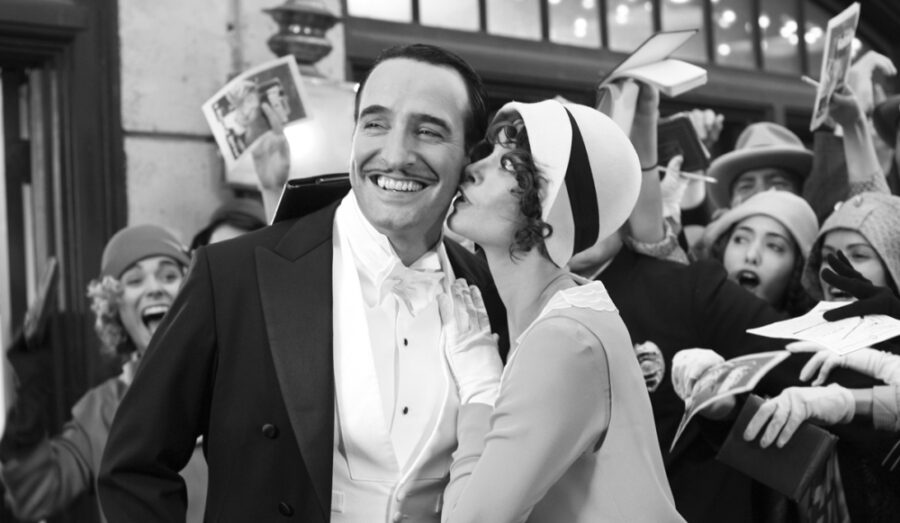The prohibitive favorite for Best Picture at this Sunday’s 84th annual Academy Awards is Michel Hazanavicius’ black and white silent film The Artist. The film, which is nominated for a total of ten Oscars, is about a silent era movie star struggling to cope in an industry changing with the advent of “talkies.” George Valentin, the fictional main character played brilliantly by French actor Jean Dujardin, is one of Hollywood’s first stars in the early days of film. Fans love him and, as a result, the producers and the studio love him. He doesn’t need words to convey a story. His personality of his characters which jumps off the screen and his considerable dancing acumen lead him to fame and fortune. George’s success goes to his head. In his luxurious home hangs a life-size portrait of himself. His dog who costars in many of his films receives more of his attention than his wife does.
But then the talking pictures begin to emerge. George believes they’re a fad and that they’ll never replace the silent films that people know and love. As time moves on and movie offers stop showing up, George realizes he’s wrong. Rather than adapt to the new technology he withdraws and hosts an extended pity party for himself. Much of the film consists in watching him go through the various stages of grief as his career, fortune, and celebrity begin collapsing around him.
As I watched his story unfold, I was struck with frustration and empathy. Frustration at his defeatist attitude and empathy for the free fall his life was taking. The average person may understand what it must be like to lose that which they’ve worked hard to achieve–be it vocational success, a house, or a retirement account–but few know what it’s like to be world renown, at the top of their craft and have it all slip away. The higher up one climbs, the longer the fall. It’s easy to see why so many child stars struggle in later life. To achieve all of that success at such a young age sets the bar at a level that’s nearly impossible to maintain. The same can be said of the founders of some of these Fortune 500 companies that have gone under. The more you’ve attained, the more you can lose. Psychologically this has to do a number on you.
Here’s where the lesson comes in. One of the prevailing themes I took away from The Artist was the folly of placing one’s hope, in measuring one’s success, in finding one’s ultimate fulfillment, in worldly achievements. Jesus put it this way in the Sermon on the Mount: “Do not lay up for yourselves treasures on earth, where moth and rust destroy and where thieves break in and steal, but lay up for yourselves treasures in heaven, where neither moth nor rust destroys and where thieves do not break in and steal. For where your treasure is, there your heart will be also” (Matthew 6:19-21) The lesson is a simple one and the passage is one that any Sunday School grad is familiar with. Yet sometimes it takes the visual depiction of a movie to remind us of some of the most basic truths.
I couldn’t help but look at the life of George Valentin and think how different his response to his withering movie career would’ve been if he had the perspective Jesus taught in that passage, if his identity was in Christ and not in box office success. If this life were all we had, a failed career or dwindling wealth would be a lot more tragic. But if we find ourselves in Christ and our perspective is eternal, there is hope in the midst of every struggle. Even when we experience success in this life we can say with Paul, “I count everything as loss because of the surpassing worth of knowing Christ Jesus my Lord” (Philippians 3:8).





2 Comments
Leave your reply.